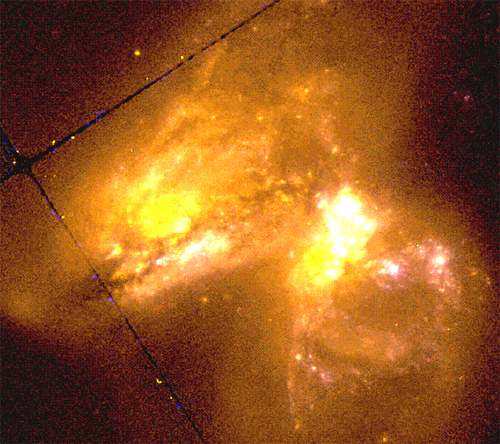Key Takeaways:
Most stars form in clusters, so astronomers look to these objects for insights into the star-formation process. Trouble is, young clusters become visible to optical telescopes only after they’ve emerged from their natal clouds.
Sometime in the past 10 million years, the galaxy Arp 299 underwent a furious burst of star formation. Astronomers first used the term “starburst” in connection with this object, which is really a pair of colliding galaxies (IC 694 and NGC 3690). Massive stars formed in this latest round should be ending their lives as supernovae now. Five supernovae have popped off in the galaxy’s outskirts since 1990 — including this year’s SN 2005U.
Dust is so thick in Arp 299’s nuclei the only radio waves offer a glimpse of star formation there. In 2003, James Ulvestad (National Radio Astronomy Observatory), Susan Neff (NASA’s Goddard Space Flight Center), and Stacy Teng (University of Maryland) identified four compact radio sources they characterized as young supernovae — all within a span of 330 light-years in the eastern nucleus. They dubbed the region a supernova factory.
“The discovery of apparent young supernovae in the western nucleus confirms it underwent its burst of star formation at approximately the same time as the eastern nucleus, despite the fact that they are separated by tens of thousands of light-years,” Ulvestad says. This is consistent with models of large-scale galaxy mergers, which show starbursts can occur almost simultaneously over very large distances.
“It was quite exciting to see the young supernovae show up in the second nucleus,” Ulvestad tells Astronomy. “The power of the Green Bank Telescope added to the VLBA, as well as new capabilities for imaging wide fields of view at milliarcsecond resolution, was essential to make this discovery possible.”
The team also found additional supernova remnants in the eastern nucleus, bringing the total to 15. Each individual supernova pumps out 100 times the radio energy of Cassiopeia A, the strongest supernova remnant in our Milky Way. Because all of these sources are less than 1.3 light-years across, the astronomers say, they’re likely to be quite young.
“We believe we’re seeing only the tip of the iceberg,” Ulvestad says. “These compact supernovae represent less than 10 percent of the radio emission seen from each nucleus at lower resolution. The remainder of the radio emission not detected by the VLBA must be in a large number of fainter supernovae and in more diffuse radio emission generated by supernovae that may have exploded tens to hundreds of thousands of years ago,” he explains.
Arp 299 lies 134 million light-years away in Ursa Major. Its component galaxies made one close pass about 700 million years ago. From this interaction, gas, dust, and stars were hurled into debris trails stretching nearly half a million light-years.
Ulvestad and his colleagues have been observing the galaxy every 6 months since December 2003. In June, they plan to see if SN 2005U can be detected as a compact radio source and look for emission related to a visible-light flare from the galaxy’s western nucleus that took place in January.
The team presented its results yesterday at the American Astronomical Society meeting in Minneapolis.










